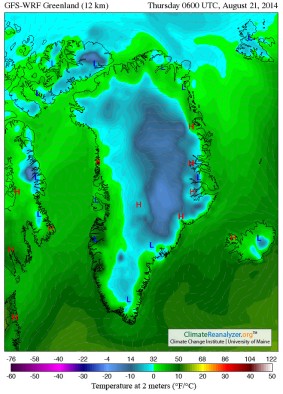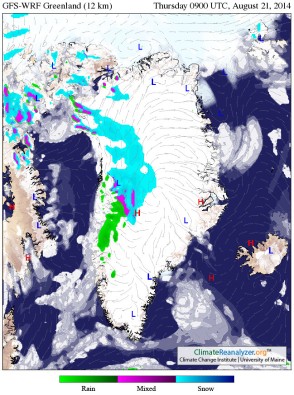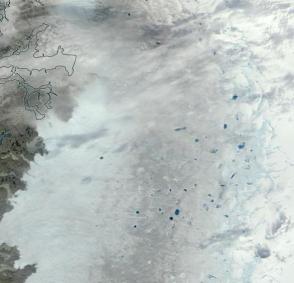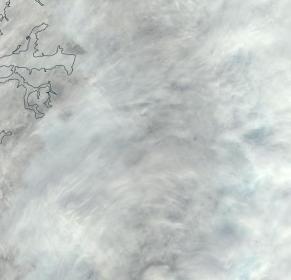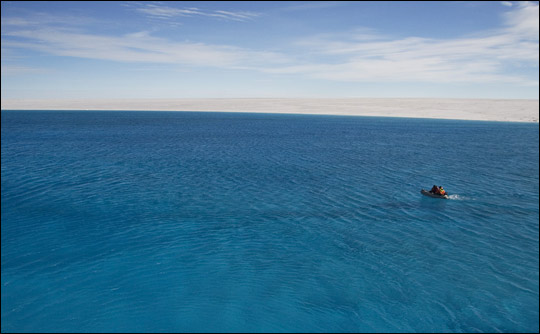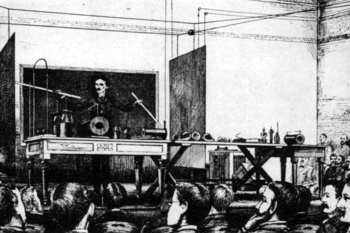Glacial melt ponding on steep ice faces. Above freezing temperatures for an extended period. Storms delivering rainfall to the glacier surface.
These three events are a bad combination and one that, until recently, we’ve never seen before for Greenland. It is a set of circumstances directly arising from a human-driven warming of the great ice sheet. And it is one that risks a highly violent and energetic event in which melt ponds over-top and glaciers are flushed and ripped apart by surges of water rushing for scores of miles over and through the ice sheet. Major melt pulse events called glacier outburst floods that can result in catastrophically large volumes of water and broken ice chunks issuing from the towering, melting glaciers of Greenland and Antarctica.
It’s a risk we face now, as the circumstances driving the risk of such an event are present today.
Rain over Ice on August 21, 2014
Over the past four days a high amplitude wave in the Jet Stream and coordinate domes of high pressure over Greenland have delivered well above average temperatures for the great Northern Hemisphere ice sheet. Near and just to the east of the Jakobshavn glacier on the West Coast of Greenland, temperatures have ranged between 5 and 10 degrees Celsius above average.
(GFS temperature and rainfall analysis for Greenland on August 21, 2014. Note the above freezing temperatures and rainfall over the region of the Jacobshavn Glacier for today. Image source:
University of Maine’s Climate Reanalyzer.)
What this means is a persistence of average temperatures in the range of 34-40 degrees (F) over large sections of Greenland’s Jakobshavn glacier. Melt level readings over a region that has now experienced ongoing surface ponding for more than 60 days.
But these warm temperatures, providing yet more heat forcing to melt the ice, aren’t the only extreme weather factor for the Jakobshavn glacier today. For today has brought with it a warm, wet over-riding airmass emerging from Baffin Bay and the Atlantic Ocean to the south. The warm air, coming into contact with the cooler glacier air is condensing and disgorging a series of rainstorms, dumping above-freezing water into the Jakobshavn’s already swelling pools.
Some of these effects are directly visible in the LANCE MODIS satellite imagery provided by NASA.
Glacial melt ponds are indicated in the satellite shot below by light-to-dark blue splotches on the glacier surface. Shallow surface melt ponding and pooling is indicated by a thin skein of light blue. In the left frame below, you can see the extensive and large melt ponds in the region of the Jakobshavn Glacier on August 18, 2014. For reference, the largest of these ponds are between 2 and 4 kilometers across. Also note the pale blue color of the ice near the larger ponds, indicating extensive smaller ponds in the region.
In the right frame, we have today’s LANCE-MODIS satellite shot. You will note that the entire frame is covered by cloud but that you can still see the blue undertone of the melting glacier below the rain-bearing clouds.
(LANCE MODIS satellite shot of the Jakobshavn Glacier on August 18 [left frame] and August 20 [right frame]. Note the widespread melt ponds and blue ice indicating smaller ponds over the glacier structure. Image source:
LANCE MODIS.)
Assessing Glacial Outburst Flood Risk
Some day, as Greenland continues to warm under the human heat forcing and as more hot air invasions ride up over the ice sheet, a period of warmth followed by rainstorms may well set off a major outburst flood event. The water content in melt ponds over the glacier may well be far greater than what we see now and a series of over topping events, starting higher on the ice sheet and magnifying toward the ice sheet base, would set of a chain of events leading to such a flood.
Risks for this kind of event today may well be moderate to low. The glaciers at this point are craggy and much of the flood waters shunt through holes in the ice to water pockets or to the glacier base. But eventually, as the glacier contains more water through subsequent years of melt, flooding and damming will be more prevalent throughout the ice sheet. And so risks will likely be on the rise.
Other than similar events occurring in the Himilayas, we don’t really have much of a context by which to judge risk for large Greenland outburst flood events. We do know that melt ponding is now quite extensive in this region and we do know that the glacier itself is rather unstable — moving with rapid speed toward the ocean and containing pockets of melted water from past melt pond formation over the last two decades.
For today, I’m pointing out the current rainfall over ice and melt ponding event as part of a larger and dangerous trend, one that is likely to play a primary role in the pace and violence of Greenland melt going forward.
(Photograph of a zodiac on the surface of one of Greenland’s very large melt ponds. Image source:
Earth Observatory.)
Links:


















